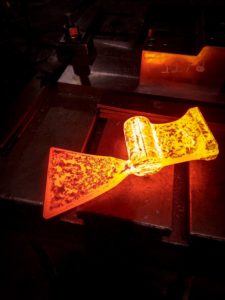Understanding The Different Metal Forging Methods
Forging By Tooling a row of die/tooling that will be used to forged automotive components The words “die” and “tooling” are often used interchangeably in the forging industry. They refer to the device that is used to shape a (usually pre-heated) billet, ingot, preform, or bar. When comparing forging by the tooling that is used, there are three primary methods: impression die, open die, and rolled ring.

Impression Die Forging
With impression die forging, metal is squeezed/compressed between two custom dies that each have pre-cut profiles/cavities (or impressions) of the final part shape.
Then, using various types of equipment, like a mechanical press or a drop hammer, the billet or preform is compressed while it undergoes plastic deformation. In each impression, the workpiece is forced into the cavity as the flash (excess metal) flows out into the die. As the flash cools, pressure builds up in the impression which helps ensure a more uniform component. Then, the flash is removed either manually or with trimming dies.
Impression die forging is primarily used for manufacturing complex symmetrical and asymmetrical forged components. This method can also achieve closer tolerances when compared to open die forging.
Open Die Forging
In open die forging, a workpiece (ingot, bar, billet, or preform) is deformed between an upper and lower flat-faced die, and the movement of the workpiece itself is largely what helps shape the final part.
In addition to flat-faced dies and hammers (or presses), there are other tools that can be used in open die forging, including saddles, blocks, rings, mandrels, and punches.
The components made in open die forging are usually simple in shape (long and rectangular, flat and round, etc.) and can be further machined after the forging process.
Open die forging is used to produce components of all sizes, but, when it comes to complexity, impression die forging is usually the preferred method over open die forging.
Rolled Ring Forging
The last method by tooling is rolled ring forging. Unlike impression die and open die, the roll forging method does not utilize dies, and it is used to make very specific shapes: rings.
This forging process can be used to make all types and sizes of seamless rings. Roll forging is preferred over machining, cutting, and casting because it can produce components to tight tolerances. Additionally, forging eliminates internal porosity, unlike casting, which reduces creep, fatigue, and other issues.
In roll forging, the stock is usually preformed. The preform technique used in roll forging is called punching. As the name implies, a hole is punched into the stock, creating a donut shape. Then, the preform is run through a rolling mill until the final component is produced.
All types of components can be created by roll forging, including engine bearings, wheel bearings, flanges, and gears.
Forging Processes By Temperature

Metal forging processes can also be categorized by the actual temperature of the workpiece. Different temperatures affect the plasticity of the metal, the final quality of the piece, and can determine many of the component’s final mechanical properties, including strength, ductility, and resistance to impact or fatigue.
When categorizing forging by temperature, there are three primary methods: hot, warm, and cold.
Hot Forging
In hot forging, typically the dies/tooling are pre-heated to a specific temperature and then the workpiece itself is heated to a predetermined temperature. The temperature used in hot forging varies based on the raw material being used, the component that is being produced, and any specific application requirements.
In hot forging, heat makes the metal more ductile, and the consistent pressure of the dies squeezing hot metal produces a more refined grain structure and thus stronger, more ductile components.
Warm Forging
In warm forging, a workpiece is heated within a specific range: above work hardening temperature, but below the scaling temperature.
Warm forging covers a range of forged products that do not require the expense and tight tolerances of cold forging or the higher strength yield of hot forging. Warm metal forging is typically used for parts that are already close to their final shape, such as shafts and gears.
Cold Forging
As the name suggests, the cold forging process is performed at cooler temperatures (anywhere between room temperature to just a few hundred degrees).
Cold forging also utilizes other processes including bending, coining, rolling, and extruding, depending on the type of component that is being produced. The metal used in the process is also typically annealed or softened during the forging process, and continuous lubrication is required during this process to prevent frictional heat.
Although cold forging is extremely precise, and often requires little to no finishing work, hot forging is still the preferred method for complex, custom forgings. Additionally, components that are cold-forged are more likely to contain residual stresses, which can eventually lead to cracking, warping, and other issues.










